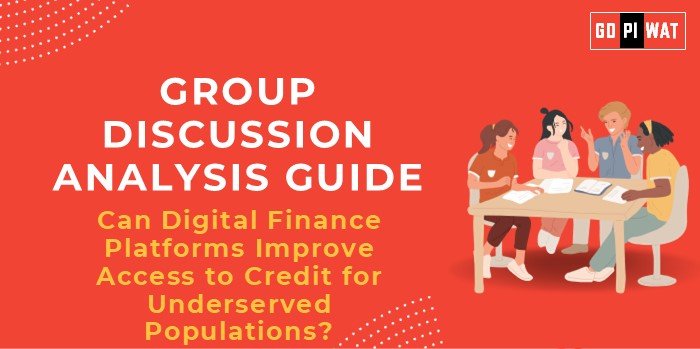📋 Group Discussion (GD) Analysis Guide
💡 Topic: Can Digital Finance Platforms Improve Access to Credit for Underserved Populations?
🌐 Introduction
Digital finance platforms are reshaping global financial ecosystems, particularly in underserved regions. Advancements in mobile banking, AI-based credit scoring, and digital lending promise to democratize credit access. However, their success hinges on addressing systemic challenges such as digital literacy and infrastructure gaps.
📊 Quick Facts & Key Statistics
- 🌍 Global Unbanked Population: 1.4 billion adults as of 2021, highlighting gaps in access to formal financial services.
- 🇮🇳 India’s Financial Inclusion Growth: Adults with bank accounts rose from 35% in 2011 to 80% in 2017, driven by initiatives like Jan Dhan Yojana.
- 📈 Digital Loan Market in India: Valued at $270 billion in 2022, projected to reach $350 billion by 2023, reflecting rapid adoption of digital lending.
- 📱 Microfinance Digital Penetration: Digital loans to account for 40% of total microfinance loans by 2027, up from 15% in 2020.
👥 Stakeholders and Their Roles
- 🏛️ Government Agencies: Policymaking, infrastructure development, and financial literacy campaigns.
- 💻 Private Fintech Firms: Innovation in credit delivery, such as AI-driven credit scoring models.
- 🌐 Global Organizations: Providing technical expertise and financial aid for digital finance programs.
- 🏘️ Local Communities: Participation in digital literacy initiatives to enable adoption of financial services.
✨ Achievements and Challenges
- 🏆 Achievements:
- 📈 Financial inclusion growth through digital initiatives.
- 💡 AI-based credit scoring systems facilitating microloans for individuals without formal credit histories.
- 💰 Cost reductions enabling affordable loan disbursals.
- ⚠️ Challenges:
- 🌐 Limited internet access in rural areas.
- 🔒 Cybersecurity risks and fraud concerns.
- 📖 Low digital literacy among underserved populations.
📌 Effective Discussion Approaches
- 📊 Statistical Insight: “With 1.4 billion adults unbanked globally, can digital finance platforms bridge this gap sustainably?”
- 🆚 Contrast Method: “While India’s financial inclusion has reached 80%, the rural-urban divide in digital finance adoption persists.”
Counter-Argument Handling:
- Point: “Rural populations lack internet connectivity.”
- Rebuttal: “Government initiatives like BharatNet aim to connect 250,000 gram panchayats to high-speed internet.”
🧩 Strategic Analysis of Strengths & Weaknesses
- Strengths: AI-based credit systems, scalability, and cost-efficiency.
- Weaknesses: Dependence on internet infrastructure and low awareness among rural populations.
- Opportunities: Increasing smartphone penetration, AI, and blockchain for secure lending.
- Threats: Cybersecurity vulnerabilities and regulatory challenges.
📄 Structured Arguments for Discussion
- Supporting Stance: “Digital finance platforms are revolutionizing credit access through cost-effective, scalable solutions.”
- Opposing Stance: “Without robust infrastructure and digital literacy, these platforms risk excluding the most vulnerable.”
- Balanced Perspective: “Digital finance is a game-changer, but addressing literacy, infrastructure, and cybersecurity issues is key to its success.”
🎓 Connecting with B-School Applications
- Real-World Applications: Business models for fintech, projects in microfinance digitization.
- Sample Interview Questions:
- “How can India leverage AI to improve financial inclusion?”
- “What are the cybersecurity challenges in expanding digital finance?”
- Insights for Students: Explore fintech-microfinance partnerships and assess global examples like Kenya’s M-Pesa for scaling success.


